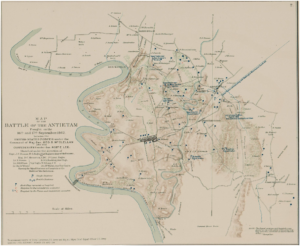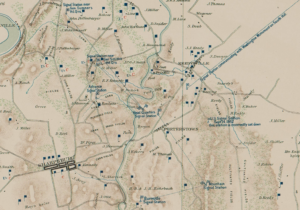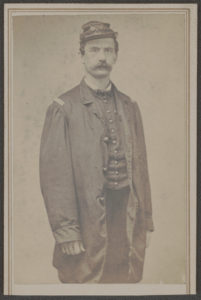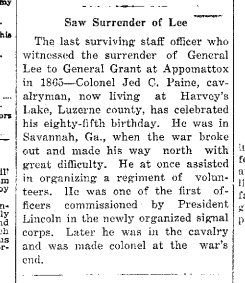US Army signal stations at Antietam
6 December 2022
I’ve consulted this fine map on more than one occasion during my recent research into signal officers and surgeons at Antietam.
It is annotated with the locations of US Army field hospitals and signal stations on and near the battlefield, and is a compilation of two earlier maps which supported the after-action reports of Army of the Potomac’s Medical Director Jonathan Letterman [report] and Chief Signal Officer Albert Myer [report].
I expect I’ll need it again, so I’ll keep a copy here.
Here’s a blow-up of the middle part of the map [touch to enlarge] focusing on the local signal stations used by the Federals during the battle of Antietam on 17 September 1862.
The signal officers who manned each station during the battle were:
Signal Station near Gen. Sumner’s Hd. Qrs.
Poffenberger farm near the Hagerstown Pike
1Lt. J.B. Brooks (4th VT)
2nd Lt. W.H. Hill (99th PA)
Signal Station near Gen. Smith’s Hd. Qrs.
Smoketown Road, East Woods
1st Lt. E.C. Pierce (3rd ME)
2nd Lt. W.F. Barrett (27th MA)
Advance Signal Station
On the Roulette farm
1Lt. F.N. Wicker (28th NY)
1Lt. G.J. Clarke (62nd NY)
…briefly, then …
1Lt. F. Wilson (5th PA Reserves)
2Lt. F.W. Owen (38th NY)
Head Quarters Signal Station
Dual station at/near the Pry house east of the Antietam
2Lt. W.S. Stryker (83rd NY)
1Lt. J.C. Paine (57th NY)
2Lt. C.F. Stone (6th ME)
1Lt. P.A. Taylor (49th NY)
Signal Station communication with the Washington Monument on South Hill
East of the Boonsboro Pike near Keedysville
[not named] possibly 2nd Lt. C.H. Cary (3rd MI)
Mountain Signal Station
On Elk Mountain east of Sharpsburg
1Lt. J. Gloskowski (29th NY)
2Lt. N.H. Camp (4th NJ)
Burnside Signal Station
Ridge on the Rohrbach farm east of the lower bridge
1Lt. S. Pierce (27th NY)
Capt. C.S. Kendall (1st MA)
All stations were under the supervision of Signal Detachment commander Capt. B.F. Fisher (3rd PA Reserves); he was most often at the Head Quarters station on 17 and 18 September.
______________
For a little about Confederate Army signal stations at Sharpsburg, see A New View of the Field at Sharpsburg, an exhibit on Antietam on the Web.
______________
Notes
The map here is part of Plate XXVIII (28) from Volume I of the Atlas to Accompany the Official Records of the Union and Confederate Armies (US War Department, 1891-95). There’s a lovely digital set of all 178 plates from the Atlas online thanks to Baylor University. Here’s their zoomable copy of Plate XXVIII.
My information about the specific manning of the signal stations comes from Major Myer’s report, with details from that of Captain Fisher [here].
Each of these officers were detailed from their regiments to the Signal Corps earlier in 1861 or 1862 and all were Acting Signal Officers (ASOs) at Antietam. Many of them were later commissioned directly in the Signal Corps.
Each officer was accompanied at his signal station by two Privates as flagmen – men also detailed from volunteer regiments to the Signal Corps.
There were at least 37 US ASOs [see their unit page on AotW] on the Maryland Campaign of 1862 and more than 110 flagmen. I regret I have identified only 3 of those Privates to date.
Lt William F Barrett, Signal Corps, USV (c. 1863)
3 December 2022
This lovely photograph of Lieutenant William Francis Barrett, complete with Signal Corps kepi, was taken by T.M. Schleier, photographer, Nashville, Knoxville & Chattanooga, TN, and is in the massive Liljenquist Family Collection of Civil War Photographs at the Library of Congress [online].
On 17 September 1862 …
… As our lines advanced on the west side of the Antietam, driving in the enemy’s left, stations were established as closely as possible behind the lines, and near to the generals commanding in that portion of the field. A station was thus established, subject to artillery fire, by Lieuts. E. C. Pierce and W. F. Barrett, at the Miller house, near the position of General E. V. Sumner. The signal package carried on the saddle by one of the flagmen of this party was cut in two by a cannon-shot.
He served through the war as a Signal Officer and mustered out in August 1865.
Sadly, William died not quite 3 weeks later of malaria or dysentery contracted on campaign, leaving a widow Ellen and small son Charles. He was 30 years old.
Saw surrender of Lee (1924)
3 December 2022
On the occasion of Jedediah Chase Paine‘s 85th birthday the Lititz (PA) Record of 10 April 1924 published this piece about his presence at Appomattox Court House in April 1865 when he was a Captain, Signal Corps, US Volunteers. He had been with the Army of the Potomac on South Mountain and at Antietam in September 1862 as a Lieutenant in the 57th New York Infantry and Acting Signal Officer.
Here’s a carte-de-visite of Captain Paine made at the Brady studios in about 1863. It was offered for sale by Dan Morphy Auctions in 2010.
____________________
Some of the claims in the news clip above are a little confusing, possibly misleading. He was not really a staff officer – rather a Signal Officer. He was one of many officers – most of the Corps, in fact – who were commissioned into the Signal Corps when it was reorganized in March 1863. He was not actually in the Cavalry, but was assigned as Signal Officer to General Stoneman in 1863. He was awarded brevets (honorary rank) to Major and Lieutenant Colonel of Volunteers in 1865.





